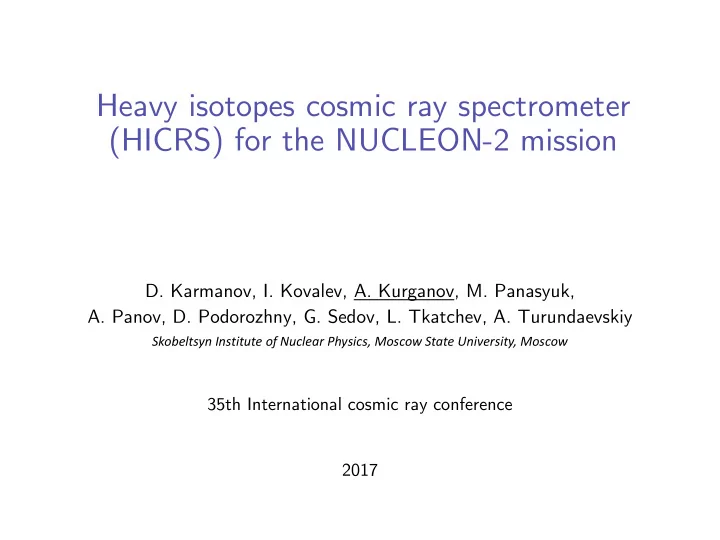

Heavy isotopes cosmic ray spectrometer (HICRS) for the NUCLEON-2 mission D. Karmanov, I. Kovalev, A. Kurganov, M. Panasyuk, A. Panov, D. Podorozhny, G. Sedov, L. Tkatchev, A. Turundaevskiy Skobeltsyn Institute of Nuclear Physics, Moscow State University, Moscow 35th International cosmic ray conference 2017
Isotope composition and scientific problems • Local environment of the sun: diffusion coefficient, radioisotope clocks, local sources • Isotopes anomalies in supernova explosions in a heavy elements-enriched medium • Reverse shock wave cosmic ray acceleration • Features of various nuclei injection process in cosmic ray acceleration
Existing data • LDEF: Z = 70-103, 1-2GeV/N, no isotope composition measurements • HEAO-3-C3: Z = 17-120, no isotope composition measurements, low statistics in Z=44-60 • SuperTIGER: Z = 10-60, 2-3 GeV/N, no isotope composition measurements • ACE/CRIS: isotope composition up to Z=32, ~10 2 MeV/N Conslusion: • Z>40: Low charge composition measurement statistics • Z>32: No isotope composition data at all • An experiment with exposure several orders of magnitude larger than of the CRIS ACE experiment is needed
The NUCLEON-2 Mission • Satellite experiment project for direct measurements of cosmic rays for the investigation of charge and isotope composition • Energy range: 0.1-1GeV/N (depends on the charge) • Z range (charge composition): 7-94 • Z Range (isotope composition): 7-66 • Exposition time: 5 years • E-dE telescope technique
Supposed NUCLEON-2 construction and arrangement Single HICRS
HICRS construction Tracker strip detectors 2mm detectors
Expected results
The prototype
The prototype
CERN Test results: Z separation
Monte-carlo simulation model construction Simulation in GEANT4, FLUKA and GEANT3
Isotopes separation in monte-carlo simulation
Isotopes separation in monte-carlo simulation (Mo, 0MeV noise)
Isotopes separation in monte-carlo simulation (Mo, 5MeV noise)
Isotopes separation in monte-carlo simulation (Sn, 0MeV noise)
Isotopes separation in monte-carlo simulation (Sn, 5MeV noise)
Conclusion • The isotope spectra is one of the recent considerable interests in the field of cosmic rays origin physics and astrophysics in general • No isotope composition data was measured above Z>32 • Statistics in the Z>40 range is low • The NUCLEON-2 mission is proposed as a solution • The monte-carlo simulation of the HICRS prototype and preliminary analysis methods confirm the proposed experiment’s isotope and charge measurement range and resolution • The project is still in development and will be launched in the year ~2020-2022
Thanks for your attention!
Isotopes separation in monte-carlo simulation
Isotopes separation in monte-carlo simulation (Dy, 0MeV noise)
Isotopes separation in monte-carlo simulation (Dy, 5MeV noise)
Isotopes separation in monte-carlo simulation (Dy, 0MeV noise)
Isotopes separation in monte-carlo simulation (Dy, 5MeV noise)
Recommend
More recommend